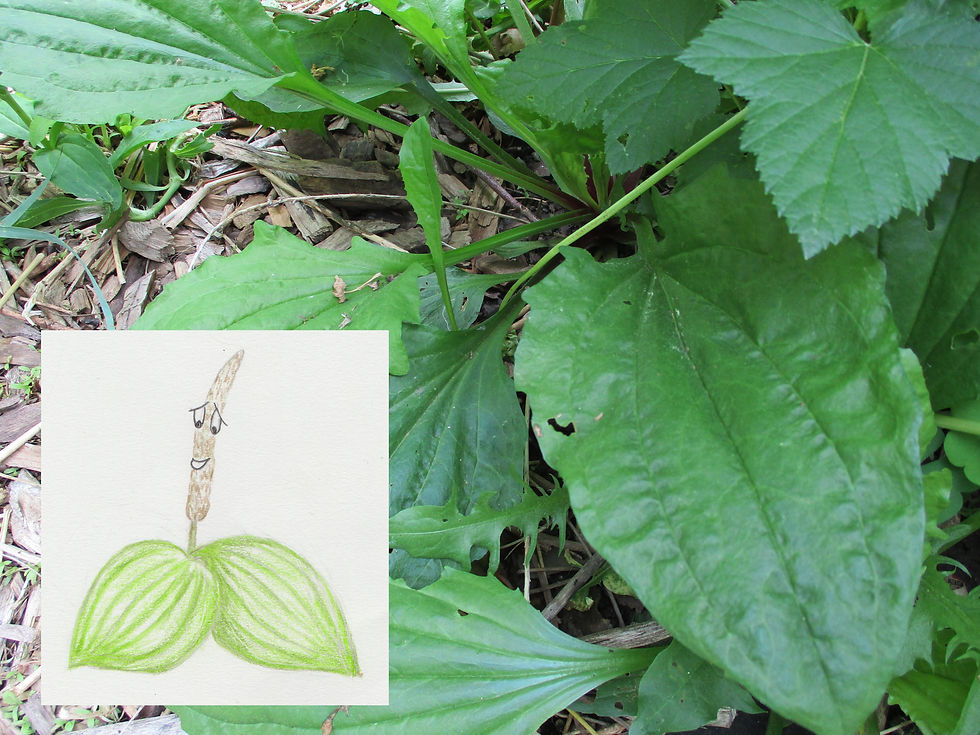I don't mind if you walk all over me...
- Laura Crystal

- Jan 26, 2021
- 2 min read
Updated: Apr 7, 2021
Plantain
Given Names: Plantago major and Plantago lanceolata- although one is broad-leaved and one narrow-leaved, their properties are almost interchangeable
Nicknames: ribwort, rat's tail, whiteman's footprint, snakeweed

Are you looking at me?
Are you sure you're not looking at the feathery yarrow leaves beside me?
Maybe you're inspecting the grass for weeds to pull?
No? Oh.
Maybe you're mistaking my paralleled-veined leaves for the leaves of a beautiful flower? Pardon? You already know that my flowering spike is simple and unimpressive, kind of like a mini cattail?
You're really saying that it's me that you're interested in?
Wow!
Why?
People don't usually pay much attention to me even though species of me are common all over the world. In fact they often step on me. I guess it's my fault for liking compacted soil. What else do I expect when I grow in soil where people walk, like lawns, paths and between cracks in the sidewalk? Good thing I don't really mind a little foot traffic. I also don't mind if you pick some of my leaves. Sure, you may not think my leaves aren't anything special but I think you might find them useful. If you'd like, you can chop them up and add them to soups and salads.
Traditionally, though, my leaves were more often used to heal cuts, sores, bites and stings. I've been told I'm soothing. If you want, you can try chewing my leaves (the broad or narrow type are both great) and putting that plant goop on a cut. I know it sounds gross. But do you think you could maybe trust me and try it? I'm kind of experienced in this stuff.
For over 1000 years I've been used in various forms in Traditional Persian medicine, I have a long history with Europeans and as soon as I was introduced to North America, First Nations began using me too. I know there are a lot of other more impressive plants out there but I hope I can help you.
Now can you please stop looking at me...I think you're making me blush.
From,
Humble Plantain
Resources Used:
Crawford, M. (2010). Creating a Forest Garden: Working with nature to grow edible crops. Cambridge: Green Books Ltd., pp 231.
Flowers, F., Wylde, B. (2014). Power Plants: Simple home remedies you can grow. Toronto: HarperCollins Publishers Ltd., pp 241- 5.
Kruger, A. (1992). Canadian Nature Guides: Herbs. New York: Smithmark Publishers Inc., pp 139.
Najafian, Y., Hamedi, S.S., Farshchi, M.K., Feyzabad, Z. (2018, February). Plantago major in Traditional Persian Medicine and modern phytotherapy: a narrative review.Electron Physician, 10(2), 6390–6399. Retrieved January 20, 2021 from https://www.ncbi.nlm.nih.gov/pmc/articles/PMC5878035/
Shababy, D. (2010). The Wild and Weedy Apothecary. Woodbury: Llewellyn Publications, pp 234-6.
Wood, M. (2008). The Earthwise Herbal: A Complete Guide to Old World Medicinal Plants. Berkeley: North Atlantic Books, pp 385.



Comments